Xiaoqing Ye
Uni$^2$Det: Unified and Universal Framework for Prompt-Guided Multi-dataset 3D Detection
Sep 30, 2024
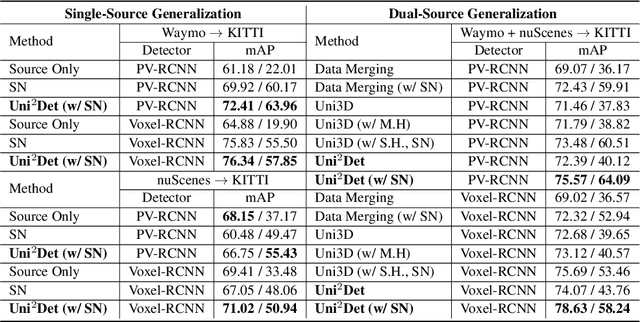
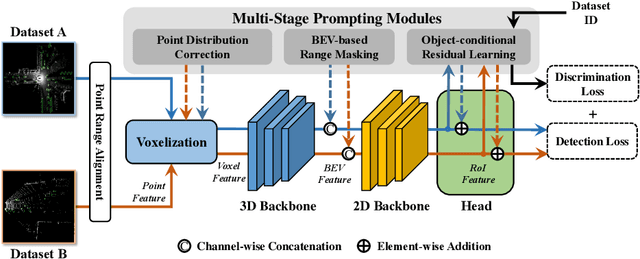
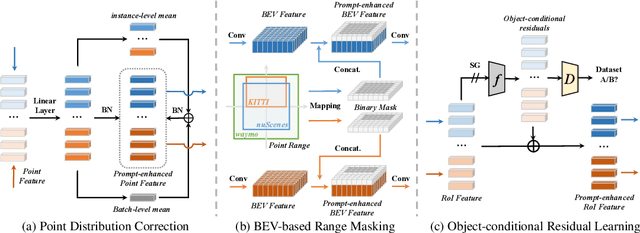
Abstract:We present Uni$^2$Det, a brand new framework for unified and universal multi-dataset training on 3D detection, enabling robust performance across diverse domains and generalization to unseen domains. Due to substantial disparities in data distribution and variations in taxonomy across diverse domains, training such a detector by simply merging datasets poses a significant challenge. Motivated by this observation, we introduce multi-stage prompting modules for multi-dataset 3D detection, which leverages prompts based on the characteristics of corresponding datasets to mitigate existing differences. This elegant design facilitates seamless plug-and-play integration within various advanced 3D detection frameworks in a unified manner, while also allowing straightforward adaptation for universal applicability across datasets. Experiments are conducted across multiple dataset consolidation scenarios involving KITTI, Waymo, and nuScenes, demonstrating that our Uni$^2$Det outperforms existing methods by a large margin in multi-dataset training. Notably, results on zero-shot cross-dataset transfer validate the generalization capability of our proposed method.
Make Your ViT-based Multi-view 3D Detectors Faster via Token Compression
Sep 01, 2024

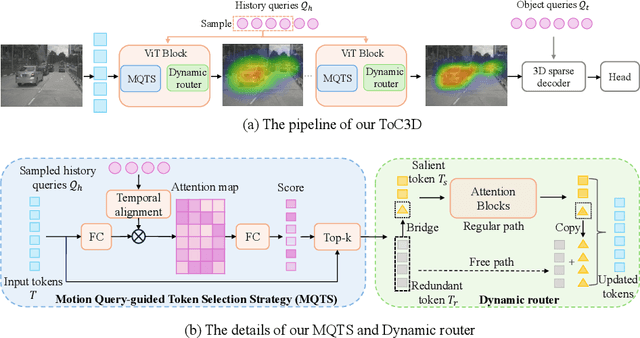
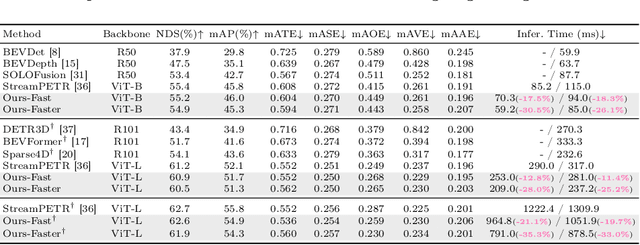
Abstract:Slow inference speed is one of the most crucial concerns for deploying multi-view 3D detectors to tasks with high real-time requirements like autonomous driving. Although many sparse query-based methods have already attempted to improve the efficiency of 3D detectors, they neglect to consider the backbone, especially when using Vision Transformers (ViT) for better performance. To tackle this problem, we explore the efficient ViT backbones for multi-view 3D detection via token compression and propose a simple yet effective method called TokenCompression3D (ToC3D). By leveraging history object queries as foreground priors of high quality, modeling 3D motion information in them, and interacting them with image tokens through the attention mechanism, ToC3D can effectively determine the magnitude of information densities of image tokens and segment the salient foreground tokens. With the introduced dynamic router design, ToC3D can weigh more computing resources to important foreground tokens while compressing the information loss, leading to a more efficient ViT-based multi-view 3D detector. Extensive results on the large-scale nuScenes dataset show that our method can nearly maintain the performance of recent SOTA with up to 30% inference speedup, and the improvements are consistent after scaling up the ViT and input resolution. The code will be made at https://github.com/DYZhang09/ToC3D.
EasyChauffeur: A Baseline Advancing Simplicity and Efficiency on Waymax
Aug 29, 2024



Abstract:Recent advancements in deep-learning-based driving planners have primarily focused on elaborate network engineering, yielding limited improvements. This paper diverges from conventional approaches by exploring three fundamental yet underinvestigated aspects: training policy, data efficiency, and evaluation robustness. We introduce EasyChauffeur, a reproducible and effective planner for both imitation learning (IL) and reinforcement learning (RL) on Waymax, a GPU-accelerated simulator. Notably, our findings indicate that the incorporation of on-policy RL significantly boosts performance and data efficiency. To further enhance this efficiency, we propose SNE-Sampling, a novel method that selectively samples data from the encoder's latent space, substantially improving EasyChauffeur's performance with RL. Additionally, we identify a deficiency in current evaluation methods, which fail to accurately assess the robustness of different planners due to significant performance drops from minor changes in the ego vehicle's initial state. In response, we propose Ego-Shifting, a new evaluation setting for assessing planners' robustness. Our findings advocate for a shift from a primary focus on network architectures to adopting a holistic approach encompassing training strategies, data efficiency, and robust evaluation methods.
LION: Linear Group RNN for 3D Object Detection in Point Clouds
Jul 25, 2024



Abstract:The benefit of transformers in large-scale 3D point cloud perception tasks, such as 3D object detection, is limited by their quadratic computation cost when modeling long-range relationships. In contrast, linear RNNs have low computational complexity and are suitable for long-range modeling. Toward this goal, we propose a simple and effective window-based framework built on LInear grOup RNN (i.e., perform linear RNN for grouped features) for accurate 3D object detection, called LION. The key property is to allow sufficient feature interaction in a much larger group than transformer-based methods. However, effectively applying linear group RNN to 3D object detection in highly sparse point clouds is not trivial due to its limitation in handling spatial modeling. To tackle this problem, we simply introduce a 3D spatial feature descriptor and integrate it into the linear group RNN operators to enhance their spatial features rather than blindly increasing the number of scanning orders for voxel features. To further address the challenge in highly sparse point clouds, we propose a 3D voxel generation strategy to densify foreground features thanks to linear group RNN as a natural property of auto-regressive models. Extensive experiments verify the effectiveness of the proposed components and the generalization of our LION on different linear group RNN operators including Mamba, RWKV, and RetNet. Furthermore, it is worth mentioning that our LION-Mamba achieves state-of-the-art on Waymo, nuScenes, Argoverse V2, and ONCE dataset. Last but not least, our method supports kinds of advanced linear RNN operators (e.g., RetNet, RWKV, Mamba, xLSTM and TTT) on small but popular KITTI dataset for a quick experience with our linear RNN-based framework.
Explore the LiDAR-Camera Dynamic Adjustment Fusion for 3D Object Detection
Jul 22, 2024Abstract:Camera and LiDAR serve as informative sensors for accurate and robust autonomous driving systems. However, these sensors often exhibit heterogeneous natures, resulting in distributional modality gaps that present significant challenges for fusion. To address this, a robust fusion technique is crucial, particularly for enhancing 3D object detection. In this paper, we introduce a dynamic adjustment technology aimed at aligning modal distributions and learning effective modality representations to enhance the fusion process. Specifically, we propose a triphase domain aligning module. This module adjusts the feature distributions from both the camera and LiDAR, bringing them closer to the ground truth domain and minimizing differences. Additionally, we explore improved representation acquisition methods for dynamic fusion, which includes modal interaction and specialty enhancement. Finally, an adaptive learning technique that merges the semantics and geometry information for dynamical instance optimization. Extensive experiments in the nuScenes dataset present competitive performance with state-of-the-art approaches. Our code will be released in the future.
OPEN: Object-wise Position Embedding for Multi-view 3D Object Detection
Jul 15, 2024



Abstract:Accurate depth information is crucial for enhancing the performance of multi-view 3D object detection. Despite the success of some existing multi-view 3D detectors utilizing pixel-wise depth supervision, they overlook two significant phenomena: 1) the depth supervision obtained from LiDAR points is usually distributed on the surface of the object, which is not so friendly to existing DETR-based 3D detectors due to the lack of the depth of 3D object center; 2) for distant objects, fine-grained depth estimation of the whole object is more challenging. Therefore, we argue that the object-wise depth (or 3D center of the object) is essential for accurate detection. In this paper, we propose a new multi-view 3D object detector named OPEN, whose main idea is to effectively inject object-wise depth information into the network through our proposed object-wise position embedding. Specifically, we first employ an object-wise depth encoder, which takes the pixel-wise depth map as a prior, to accurately estimate the object-wise depth. Then, we utilize the proposed object-wise position embedding to encode the object-wise depth information into the transformer decoder, thereby producing 3D object-aware features for final detection. Extensive experiments verify the effectiveness of our proposed method. Furthermore, OPEN achieves a new state-of-the-art performance with 64.4% NDS and 56.7% mAP on the nuScenes test benchmark.
SEED: A Simple and Effective 3D DETR in Point Clouds
Jul 15, 2024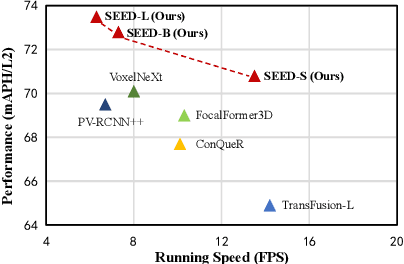
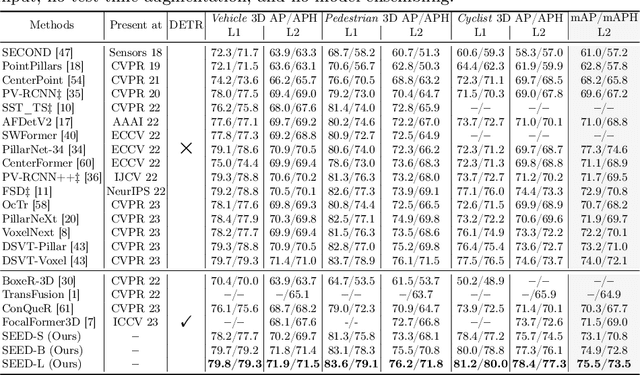

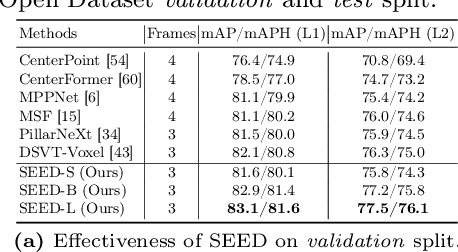
Abstract:Recently, detection transformers (DETRs) have gradually taken a dominant position in 2D detection thanks to their elegant framework. However, DETR-based detectors for 3D point clouds are still difficult to achieve satisfactory performance. We argue that the main challenges are twofold: 1) How to obtain the appropriate object queries is challenging due to the high sparsity and uneven distribution of point clouds; 2) How to implement an effective query interaction by exploiting the rich geometric structure of point clouds is not fully explored. To this end, we propose a simple and effective 3D DETR method (SEED) for detecting 3D objects from point clouds, which involves a dual query selection (DQS) module and a deformable grid attention (DGA) module. More concretely, to obtain appropriate queries, DQS first ensures a high recall to retain a large number of queries by the predicted confidence scores and then further picks out high-quality queries according to the estimated quality scores. DGA uniformly divides each reference box into grids as the reference points and then utilizes the predicted offsets to achieve a flexible receptive field, allowing the network to focus on relevant regions and capture more informative features. Extensive ablation studies on DQS and DGA demonstrate its effectiveness. Furthermore, our SEED achieves state-of-the-art detection performance on both the large-scale Waymo and nuScenes datasets, illustrating the superiority of our proposed method. The code is available at https://github.com/happinesslz/SEED
Exploring the Causality of End-to-End Autonomous Driving
Jul 09, 2024
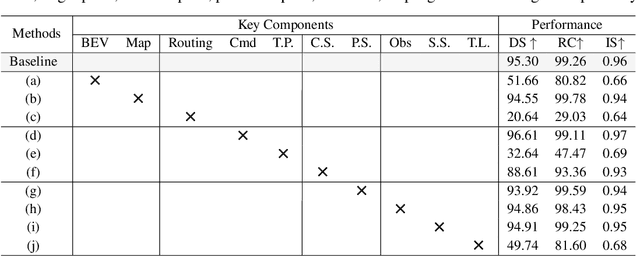
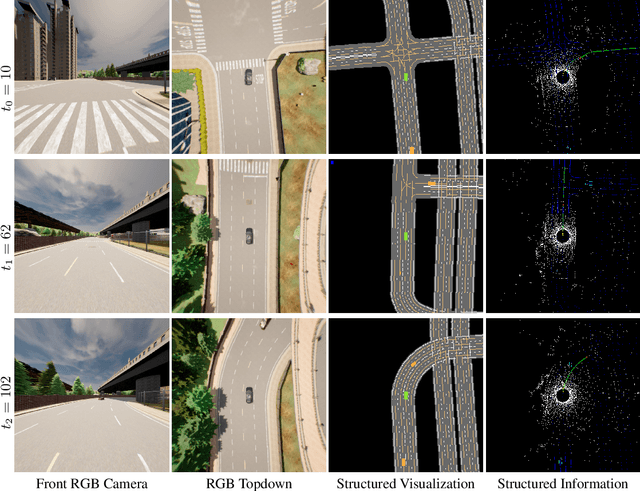

Abstract:Deep learning-based models are widely deployed in autonomous driving areas, especially the increasingly noticed end-to-end solutions. However, the black-box property of these models raises concerns about their trustworthiness and safety for autonomous driving, and how to debug the causality has become a pressing concern. Despite some existing research on the explainability of autonomous driving, there is currently no systematic solution to help researchers debug and identify the key factors that lead to the final predicted action of end-to-end autonomous driving. In this work, we propose a comprehensive approach to explore and analyze the causality of end-to-end autonomous driving. First, we validate the essential information that the final planning depends on by using controlled variables and counterfactual interventions for qualitative analysis. Then, we quantitatively assess the factors influencing model decisions by visualizing and statistically analyzing the response of key model inputs. Finally, based on the comprehensive study of the multi-factorial end-to-end autonomous driving system, we have developed a strong baseline and a tool for exploring causality in the close-loop simulator CARLA. It leverages the essential input sources to obtain a well-designed model, resulting in highly competitive capabilities. As far as we know, our work is the first to unveil the mystery of end-to-end autonomous driving and turn the black box into a white one. Thorough close-loop experiments demonstrate that our method can be applied to end-to-end autonomous driving solutions for causality debugging. Code will be available at https://github.com/bdvisl/DriveInsight.
BEVWorld: A Multimodal World Model for Autonomous Driving via Unified BEV Latent Space
Jul 08, 2024Abstract:World models are receiving increasing attention in autonomous driving for their ability to predict potential future scenarios. In this paper, we present BEVWorld, a novel approach that tokenizes multimodal sensor inputs into a unified and compact Bird's Eye View (BEV) latent space for environment modeling. The world model consists of two parts: the multi-modal tokenizer and the latent BEV sequence diffusion model. The multi-modal tokenizer first encodes multi-modality information and the decoder is able to reconstruct the latent BEV tokens into LiDAR and image observations by ray-casting rendering in a self-supervised manner. Then the latent BEV sequence diffusion model predicts future scenarios given action tokens as conditions. Experiments demonstrate the effectiveness of BEVWorld in autonomous driving tasks, showcasing its capability in generating future scenes and benefiting downstream tasks such as perception and motion prediction. Code will be available at https://github.com/zympsyche/BevWorld.
SOOD++: Leveraging Unlabeled Data to Boost Oriented Object Detection
Jul 01, 2024Abstract:Semi-supervised object detection (SSOD), leveraging unlabeled data to boost object detectors, has become a hot topic recently. However, existing SSOD approaches mainly focus on horizontal objects, leaving multi-oriented objects common in aerial images unexplored. At the same time, the annotation cost of multi-oriented objects is significantly higher than that of their horizontal counterparts. Therefore, in this paper, we propose a simple yet effective Semi-supervised Oriented Object Detection method termed SOOD++. Specifically, we observe that objects from aerial images are usually arbitrary orientations, small scales, and aggregation, which inspires the following core designs: a Simple Instance-aware Dense Sampling (SIDS) strategy is used to generate comprehensive dense pseudo-labels; the Geometry-aware Adaptive Weighting (GAW) loss dynamically modulates the importance of each pair between pseudo-label and corresponding prediction by leveraging the intricate geometric information of aerial objects; we treat aerial images as global layouts and explicitly build the many-to-many relationship between the sets of pseudo-labels and predictions via the proposed Noise-driven Global Consistency (NGC). Extensive experiments conducted on various multi-oriented object datasets under various labeled settings demonstrate the effectiveness of our method. For example, on the DOTA-V1.5 benchmark, the proposed method outperforms previous state-of-the-art (SOTA) by a large margin (+2.92, +2.39, and +2.57 mAP under 10%, 20%, and 30% labeled data settings, respectively) with single-scale training and testing. More importantly, it still improves upon a strong supervised baseline with 70.66 mAP, trained using the full DOTA-V1.5 train-val set, by +1.82 mAP, resulting in a 72.48 mAP, pushing the new state-of-the-art. The code will be made available.
 Add to Chrome
Add to Chrome Add to Firefox
Add to Firefox Add to Edge
Add to Edge